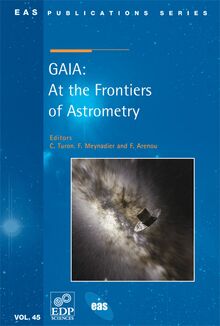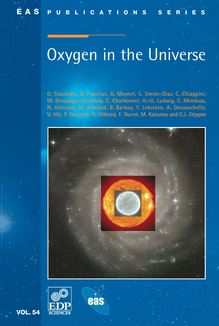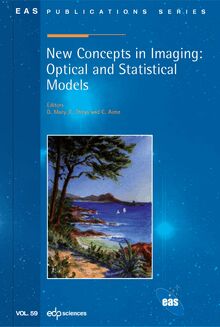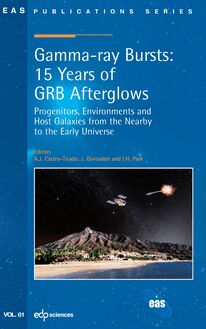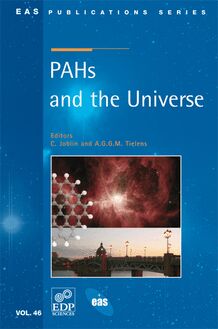-
 Univers
Univers
-
 Ebooks
Ebooks
-
 Livres audio
Livres audio
-
 Presse
Presse
-
 Podcasts
Podcasts
-
 BD
BD
-
 Documents
Documents
-
- Cours
- Révisions
- Ressources pédagogiques
- Sciences de l’éducation
- Manuels scolaires
- Langues
- Travaux de classe
- Annales de BEP
- Etudes supérieures
- Maternelle et primaire
- Fiches de lecture
- Orientation scolaire
- Méthodologie
- Corrigés de devoir
- Annales d’examens et concours
- Annales du bac
- Annales du brevet
- Rapports de stage
La lecture à portée de main
Découvre YouScribe en t'inscrivant gratuitement
Je m'inscrisDécouvre YouScribe en t'inscrivant gratuitement
Je m'inscrisEn savoir plus
En savoir plus

Description
Driven by ground-based, airborne, and IRAS observations, the PAH hypothesis was first formulated in the mid-eighties : the widespreas emission features in the 3-13 µm range are due to UV-pumped, IR fluorescence by large Polycyclic Aromatic Hydrocarbon molecules. These molecules are a ubiquitous component of the insterstellar medium both in local galaxies as well as out to redshifts of ~3 and probably beyond, play an important role in its physical and chemical characteristics, and form a key link between small hydrocarbon species and large carbonaceous grains.
This book gathers contributions that reflect the evolution of the field over the last 25 years, taking advantage of IR space missions - ISO, Spitzer and AKARI - and of dedicated experimental and quantum-chemical studies. We have now reached a stage where we can develop these mid-infrared features as diagnostic tools to study star formation processes, protoplanetary disks as well as galaxy assemblage in the early Universe. The current Herschel/Planck area opens the possibility to better characterize the mid-IR carriers through their contribution to the far-IR and mm emissions. Still, much effort is required before we will fully understand the formation and nature of interstellar PAHs and their role in the Universe. Physical chemists can play an important role in driving this field. This book aims at discussing the state-of-the-art of the PAH hypothesis and to chart the future in this interdisciplinary field. It highlights the various aspects of interstellar PAHs:
- Rich IR spectra of interstellar PAHs
- PAHs and star formation in the near and far Universe
- The lifecycle of PAHs in space
- PAHs in regions of planet formation
- PAHs and carbonaceous grains & Solar system materials.
Sujets
Informations
| Publié par | EDP Sciences |
| Date de parution | 01 juillet 2011 |
| Nombre de lectures | 0 |
| EAN13 | 9782759824823 |
| Langue | English |
| Poids de l'ouvrage | 29 Mo |
Informations légales : prix de location à la page 0,0005€. Cette information est donnée uniquement à titre indicatif conformément à la législation en vigueur.
Extrait
-
 Univers
Univers
-
 Ebooks
Ebooks
-
 Livres audio
Livres audio
-
 Presse
Presse
-
 Podcasts
Podcasts
-
 BD
BD
-
 Documents
Documents
-
Jeunesse
-
Littérature
-
Ressources professionnelles
-
Santé et bien-être
-
Savoirs
-
Education
-
Loisirs et hobbies
-
Art, musique et cinéma
-
Actualité et débat de société
-
Jeunesse
-
Littérature
-
Ressources professionnelles
-
Santé et bien-être
-
Savoirs
-
Education
-
Loisirs et hobbies
-
Art, musique et cinéma
-
Actualité et débat de société
-
Actualités
-
Lifestyle
-
Presse jeunesse
-
Presse professionnelle
-
Pratique
-
Presse sportive
-
Presse internationale
-
Culture & Médias
-
Action et Aventures
-
Science-fiction et Fantasy
-
Société
-
Jeunesse
-
Littérature
-
Ressources professionnelles
-
Santé et bien-être
-
Savoirs
-
Education
-
Loisirs et hobbies
-
Art, musique et cinéma
-
Actualité et débat de société
- Cours
- Révisions
- Ressources pédagogiques
- Sciences de l’éducation
- Manuels scolaires
- Langues
- Travaux de classe
- Annales de BEP
- Etudes supérieures
- Maternelle et primaire
- Fiches de lecture
- Orientation scolaire
- Méthodologie
- Corrigés de devoir
- Annales d’examens et concours
- Annales du bac
- Annales du brevet
- Rapports de stage
